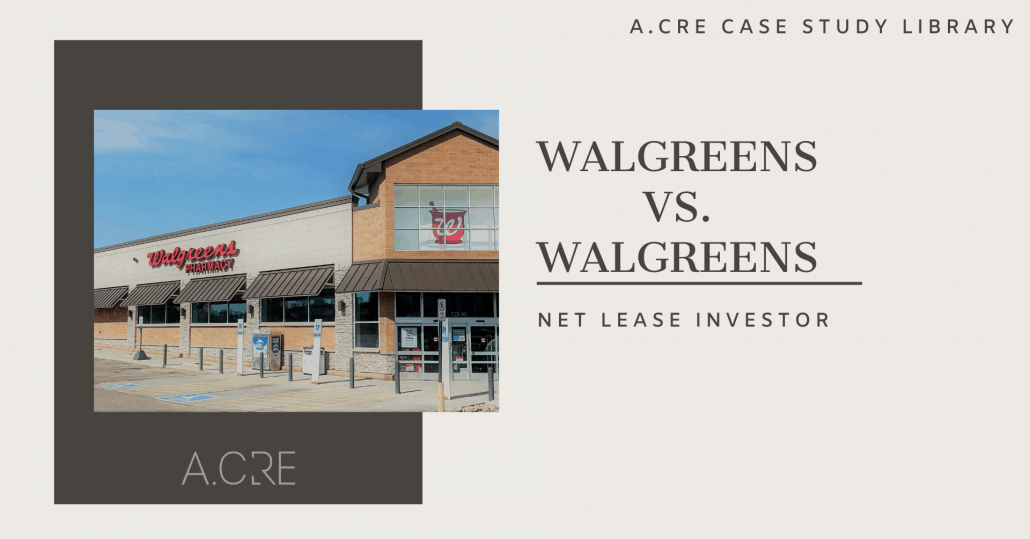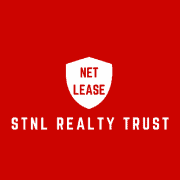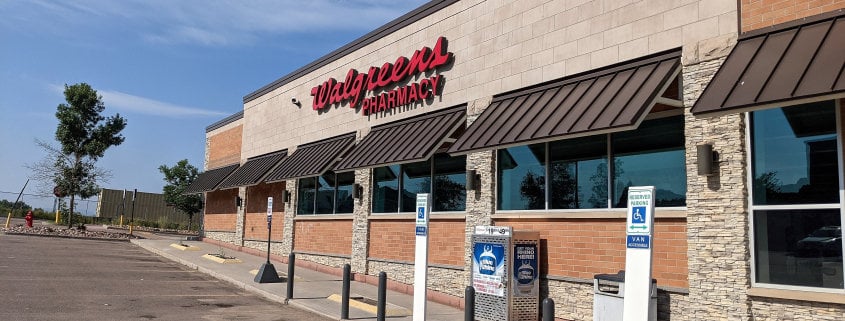Case Study #8 – Walgreens vs. Walgreens – STNL Investor (Case + Solution, Updated June 2024)
This is the 8th real estate case study in a series of commercial real estate case studies shared by A.CRE. These case studies are meant to help you practice to master real estate financial modeling. The Walgreens vs. Walgreens – STNL Investor case study puts you in the role of a private investor looking to invest up to $8 million into one single-tenant, net lease retail asset leased to Walgreens.
In this case, you’re provided with two Walgreens options. You must underwrite each, and then make a conclusion as to which you’d ultimately buy and why.
Practice makes perfect! This is a real scenario based on actual properties and situations. Names and locations have been changed for confidentiality reasons, but the fundamentals are real-to-life.
Each case study shared in this series mirrors real world situations, either in terms of the types of deals you will look at in various roles or the types of modeling tests you’ll be required to perform as part of the interview process. You can browse this and other case studies in the A.CRE Library of Real Estate Case Studies.
Are you an Accelerator Advanced member? Download this case study and solution files for free in the Career Advancement Endorsement. Not yet an Accelerator member? Consider enrolling today in the Accelerator, the industry’s go-to real estate financial modeling training program used by top companies and elite universities to train the next generation of CRE professionals.
Inheritance Without a Home
It’s been six months since your grandmother of 97 died, and you still miss her. She was a big part of your life. She raised you after your parents passed and has been by your side for over 7 decades. And while she lived a long and full life, and her passing wasn’t a huge surprise, you still miss having her around.
As her sole heir, she passed to you an inheritance of nearly $6.0 million. That inheritance has been sitting in the bank earning 4.00% annually. You know it’s time to find a home for that money but have been slow to invest it.
As a second-year Acquisitions Associate at STNL Realty Trust, you have five years’ experience analyzing net lease retail investments. This is the first time, however, that you are looking to invest for your account. For some reason, it seems much more real this time.
 About STNL Realty Trust (FLSE: xSTNL)
About STNL Realty Trust (FLSE: xSTNL)
In 1991, James Croft founded STNL Development, the predecessor to STNL Realty Trust. From 1991 to 2007, Mr. Croft developed over 201 single-tenant net lease retail properties for some of the largest companies in the United States.
With an Initial Public Offering of 5.0 million shares in 2007, STNL Realty Trust commenced operations as a publicly traded Real Estate Investment Trust (REIT). STNL Realty Trust is listed on the Fort Lauderdale Stock Exchange under the ticker symbol xSTNL.
Today, STNL Realty Trust is a $2.4B+ industry leader in the acquisition and development of properties net leased to the foremost retailers in the United States. As of the beginning of this year, the Company owned and operated a portfolio of 813 properties, located in 43 states and containing approximately 8.1 million square feet of gross leasable space.
Your Experience at xSTNL
You started with STNL Realty Trust straight out of Georgecity University, where you earned a bachelor’s degree in Real Estate Finance and Business. For three years, you worked as an Acquisitions Analyst at xSTNL assessing acquisitions for the team’s STNL pharmacy group.
Two years ago, you were promoted to Associate and have progressively taken on more responsibility. Most of your time is spent i) reviewing offering memoranda on standalone real estate leased long-term to tenants such as CVS, Walgreens, and Rite-Aid, ii) analyzing those opportunities, and iii) more recently leading the negotiation to purchase those assets.
Over your 5+ year career at STNL Realty Trust, you have analyzed over 150 assets and closed on 27 assets, with a total invested value of $175.5 million.
Investing for Your Own Account
With a healthy inheritance burning a hole in your proverbial pocket, you’ve decided to put that money into an asset that will yield you durable, long-term, consistent cash flow. And given your expertise in the STNL retail space, and especially investing in pharmacy assets, you’ve decided to stick to what you know.
Your firm recently hit its allocation to STNL pharmacy this year and doesn’t plan any further investment into the space until January of next year. And so, despite the conflict of interest, they have agreed to let you purchase one Walgreens asset for your own account.
You make several calls to brokers that focus on pharmacy and scour www.CREXI.com for potential buys. In that effort, you come across two Walgreens stores that look promising and decide to do some financial analysis on each.
Walgreens Flat Lease vs. Walgreens with Rental Increases
The two Walgreens you’re analyzing both have 15 years remaining on the base lease term, with eight, 5-year options to renew. Both properties are in strong metro areas, on hard corners, with vehicle traffic counts in front of the stores in excess of 50,000 per day. Not surprising, both locations also have above-average stores sales.
However, the economics of the two assets are quite different. Among other things, the lease on one of the properties is flat through the base term and options, while the second has 5% rental increases every five years. Therefore, to make your decision it’s necessary to model each and determine which has the more attractive economics.
Case Study Task – Walgreens vs. Walgreens
Walgreens Flat Lease – Assumptions
- Address: 5000 Wonderland Road, Large Town, Any State
- GLA: 14,450 SF
- Land Area: 93,654 SF
- Replacement Cost (excluding land value): $300/SF
- Land value: $15/SF
- Year Built: 2008
- In-place NOI: $400,250
- Asking price: $5,520,690
- Base term remaining: 180 months
- Options: 8, 5-year options
- Rental increases: None
- Lease type: Absolute NNN
Walgreens with Rental Increases – Assumptions
- Address: 1232 Jones Blvd, Big Town, Any State
- GLA: 14,775 SF
- Land Area: 126,324 SF
- Replacement Cost (excluding land value): $300/SF
- Land value: $25/SF
- Year Built: 2003
- In-place rent: $327,075
- Asking price: $5,031,923
- Base term remaining: 180 months
- Options: 8, 5-year options
- Rental increases: 10% every five years; next rental increase in month 60 of the analysis
- Lease type: Absolute NNN
General Investment Assumptions
- 10-year analysis period
- Acquisition costs of 1% of the asking price
- All-cash purchase (i.e. no financing)
- All operating expenses are paid by the tenant
- No capital expenditures over the hold period
- Reversion cap rate is 50 bps above the acquisition cap rate
- Reversion based on year 11 NOI
- Selling costs equal to 2% of the selling price
- Market Rent: $24/SF, growing by 2% per year
Answer the Following Questions for Each Property
- Is in-place rent/SF above or below Market rent/SF and by how much?
- Is the asking price/SF above or below replacement cost and by how much?
- What is the average free and clear return over the 10-yr hold period?
- What is the unlevered IRR over the hold period?
- What is the unlevered equity multiple over the hold period?
- Which property yields a higher average free and clear return?
- Which property yields a higher unlevered IRR?
- Which property yields a higher unlevered equity multiple?
- In your opinion, which is the better investment and why?
Create Your Own Case Study
This STNL case study offers a view of the decisions involved in a one single-tenant, net lease retail asset investment. As you apply the provided data and strategies in your career interviews and financial models, you’ll gain insights into optimizing asset value and ensuring investment criteria are met, key skills for any CRE professional. For those looking to deepen their expertise, our Real Estate Case Study Creator provides a platform to test and enhance your modeling skills in a controlled, realistic setting. This GPT creates completely custom real estate case studies from scratch and allows users to craft case studies to simulate scenarios they are interested in or expect to encounter in their professional lives. This customization allows users to focus on particular areas of interest or challenge, making the practice sessions as relevant and effective as possible.
Additionally, our STNL valuation GPT can further enhance your ability to understand and evaluate single-tenant net lease properties. With this tool, you can gain a more precise understanding of the nuances involved in STNL valuations, aiding in better investment decision-making.
We encourage both seasoned practitioners and newcomers to use these resource to refine their approach and decision-making in commercial real estate investments.
- Note: Custom GPTs are now available to both paid and free users of ChatGPT. Click here to learn more.
Download the Case PDF + Excel Test Worksheet + Solution
In addition to the web-based case, we’ve created a PDF version to download and use offline. Additionally, we’ve added a solution created by Spencer and Michael. Note that the solution may contain errors – if you spot an error, please let us know and we’ll roll out an update.
As with our real estate financial models, this case study and solution are offered on a “Pay What You’re Able” basis with no minimum (enter $0 if you’d like) or maximum (your support helps keep the content coming). Just enter a price together with an email address to send the download link to, and then click ‘Continue’.
We occasionally update these cases and solutions (see version notes). Paid contributors will receive lifetime access to the case, solution, and all updates.
Frequently Asked Questions about the Walgreens vs. Walgreens – STNL Investor Case Study
Version Notes
v1.1
- Fixed error on Side-by-Side in cell H15 (acquisition price is 9% below replacement, NOT 9% above)
- Updated case assumptions and solution with more up-to-date values
v1.0
- Initial release


 About STNL Realty Trust (FLSE: xSTNL)
About STNL Realty Trust (FLSE: xSTNL)







